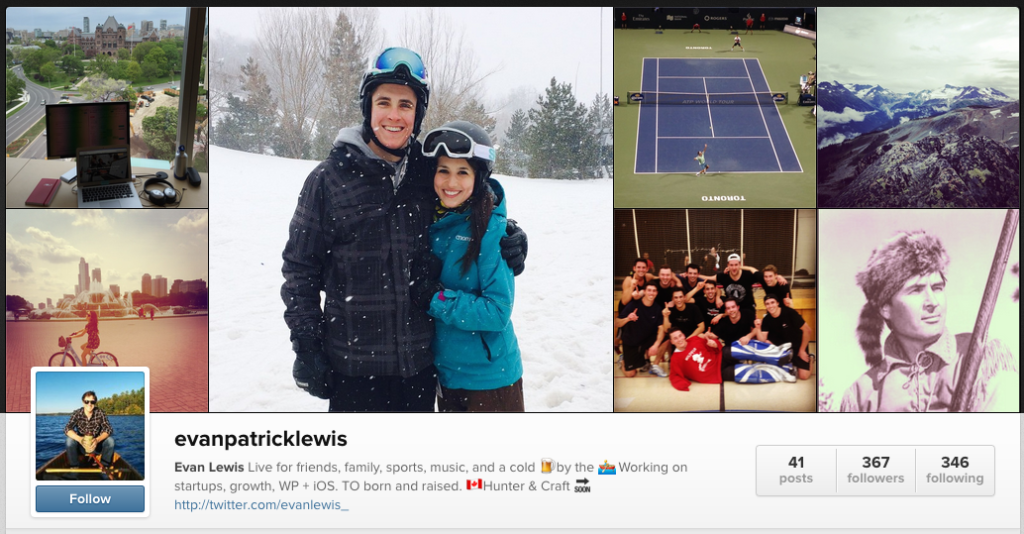There is a lot of talk these days about personal branding. At first, it’s a slightly odd concept to wrap your head around, and saying the term almost makes you feel pretentious. “I’m not a brand… Chanel and Dior are brands… how can I have a brand?”
Well think about that… Chanel was named after Coco Chanel, and Dior after Christian Dior. So those two icons just have really successful personal brands that they extended into retail and luxury goods.
In the age of social networking, your personal brand is the collective experience that people have when trying to learn about you online. When someone wants to know what you’re all about, they’ll check you out on Google, which will lead them to your LinkedIn, Facebook, Twitter, Instagram, {insert list of networks}. The bios and articles they read, the pictures they see, the videos they watch, and the impression they get of you through this series of clicks…. that is your personal brand.
Why Is Your Personal Brand Important?
It’s a cliche, but it’s true – reputation is everything. Whether you are interviewing for a job, applying to a school, or trying to sell a product, you are visible online. Rather than treating this visibility as a negative – “ugh, I don’t want to be on social media – privacy is dead!” – think about it in a positive light. You have the opportunity to make a kick-ass impression on anyone, at any time.
But how do you get there? In this article, I’ll provide 7 helpful tips to give your web presence a haircut and some fresh new clothes:
- Identify your influencers
- Assess your networks
- Build consistent and well-rounded profiles
- Routinely curate and publish content
- Work on your writing
- Try something unexpected – push yourself to upgrade your skills
- Talk to the experts, soak in some hackery
Make sure you dot your i‘s and cross your T‘s, and you’ll have a growing personal brand and social presence before you know it.
Step 1: Identify your influencers
To know what a good personal brand looks like, just look around. Think about your career path and your interests. Who is doing really well in your fields? Search them on Google and figure out what they’re doing well on their own websites and social networks.
- Do they have a blog? Is it informative and modern? What calls-to-action does it have?
- Are they sharing on social media? Which networks do they use most?
- What do their social profile descriptions and bios read like? What details do they include? Do they use hashtags or keywords?
- What is their “content mix” – ie. the genres of content they share on social media. How often do they share?
- What photos do you see?
Personally, I have a core list of influencers with strong personal brands that I look up to. Dan Martell, Dave Chilton, Tom Tunguz, Kyle Porter, Fred Wilson, and Brad Feld to name a few.
Step 2: Assess your networks
This is pretty easy to do, and you may well have figured out which networks you like to focus on. But if you haven’t used social media much or you’re still developing your networks and presence, this may help you prioritize and optimize your efforts.
It’s better to do a few networks really well than to do all of them poorly. To contribute to a network, you want to do a mix of creating, sharing, consuming and interacting with content. Here are a few key questions to ask yourself:
Am I on the “Big 4”?
Twitter, Facebook, LinkedIn, Instagram. In my opinion, you should be on all of these if you can. Why? They cover all your main bases – personal network to keep up with friends, professional network to build career connections, a blend of the two, and one that is purely visual for the photographers in all of us. It’s very easy to syndicate content to all of these networks, i.e. post content to multiple networks at once, so you might as well get your profiles in order.
Do a quick scan of your profiles and take five minutes to make sure they are updated and consistent. I just took my own advice and added a fun bio on my Instagram that meshes well with my Facebook/LinkedIn/Twitter:

What networks are emerging in my line of work?
Think about what your ideal job looks like 5 years from now. What industry do you work in? What sort of online portfolio or following would be most valuable for your career? Answering those questions will help you figure out which social networks to focus on.
If you’re in fashion, it’s likely Tumblr and Snapchat. But if you’re in consulting or finance, you probably want to look at Slideshare. Entertainment, maybe it’s Vine.
Find the best networks for your industry and have strong profiles that are a creative extension of your “Big 4”.
Step 3: Build consistent and well-rounded profiles
Here are some key things to think about when designing your social profiles.
- Complete the sentence – “If someone follows me, they’ll get…” – this will help you set an overall vision for your brand.
- Bios – make sure your bios are consistent and punchy. Avoid long-winded paragraphs at all costs.
- Leverage keywords – figure out the core terms you want to be searchable for and use them in your bios and hashtags.
- Don’t be one-dimensional – show people that you have a well-rounded personality by showcasing your personal and professional interests.
- Make sure your profiles link to each other so people can easily follow you across multiple networks.
- Use high quality and consistent photos – see this blog post by Ryan Hoover for an explanation of why he never changes his profile photo.
- Keep your profiles fresh, especially your LinkedIn. Update your experiences as they happen and include descriptions and images when you can.
If you want to take your personal branding beyond social media and feel like you should have your own site, consider services like Strikingly or Branded.me. You can get a personal site up and running in minutes, and it will be consistent with your LinkedIn automatically.

Step 4: Routinely curate and publish content
Consumption & Curation
If you keep it simple and don’t use a ton of networks, you are probably in a decent routine for content consumption. If however, you’re a bit all over the place like I am, you should consider leveraging apps to make your life a bit easier.
One app that I’ve recently started using is Flipboard. Flipboard is beautiful because you can pull content from your networks and areas of interest into one highly-visual, magazine style app that is a pleasure to breeze through. Another great app is Pocket, a top “read-it-later” app. No matter where you are browsing content, you can save the link to your Pocket account. Pocket will pull the content from that link into a reading-optimized interface. It will also store the article so you can access it even if you don’t have an internet connection. If you’re suffering from information overload and want to get better at systematically consuming content, definitely check out those two apps.
Publishing
This is one of the trickiest things to manage, simply because you can share content from so many places to so many places. If you take my advice and use Flipboard, you can easily share content to most networks directly from within the app. You can achieve similar results with Feedly. No matter where you get your content from, it’s important to publish to your social feeds at a consistent cadence to share your insights and show thought leadership.
Personally, I mostly use the apps mentioned above for consuming and sharing content, and I keep tabs on my Twitter lists. I’m also lucky to have access to our company instance of PostBeyond, which provides a curated library of content that is relevant to our business. I typically login to PostBeyond on Monday morning and add posts to my queue. In just a few minutes, I’ve scheduled content that PostBeyond shares at a nice cadence throughout the week. I also use our browser extension anytime I find an article that I want to send to the rest of the team, but I’ll detail those workflows more in another post.

Step 5: Work on your writing
Writing is an important skill to master and a fun one to practice. Personally, I find many people need to focus on modernizing their writing. Today’s readers want to read content that is conversational over formal – use soundbytes over run-ons, strategic grammar and styling (short lines, dashes, —separators—) over chunky paragraphs.
Recently, I’ve started blocking off time in my calendar specifically for writing. To start, block off 2 hours every week when you have some downtime. Find your most comfortable desk setup and write. Speak from experience. You are learning life or work lessons every single day – writing is an amazing way to compartmentalize your learning and organize your thoughts.
Medium and LinkedIn Pulse are great platforms to publish your writing on. When you do publish a post, make sure to distribute it to your networks at thoughtful times. I tend to like Monday or Tuesday morning, because then you have the rest of the week to re-share it, answer comments, etc. If you can, it’s awesome to have a few alternative titles for your posts on Twitter, so you can tweet out the varying titles but link to the same article. This will also help you get a sense for which language gets the most engagement.

Step 6: Try something unexpected – push yourself to upgrade your skills
Think about your career and find complementary skills that will set you apart.
Do something most people don’t do.
The more you can speak from experience and carve out interesting niches and expertise, the better. Maybe it’s video editing, coding, or playing an instrument. Maybe it’s SEO, investing, or photoshop. Do some online courses through Udemy, Skillshare, Coursera or Treehouse. Then update your social profiles to show people you’re improving and ideally, write about your experiences.
We all have that one hobby or skill that we’ve been wanting to take up. Luckily, there’s no time like the present!
Step 7: Talk to the experts, soak in some hackery
This step was inspired by my good friend Dan Hebert, who leads marketing for us at PostBeyond. I’ve been able to witness Dan’s social media and content distribution hacks first-hand over the past few months. He’s introduced me to a host of tools and tactics that I had no idea existed. I’ve learned about things like Bundlepost, ManageFlitter, Triberr, LuckyOrange and OptinMonster, and dug deeper into WordPress Plugins, Hootsuite and Google Analytics.
So my final suggestion is to find your “Dan”. Reach out to someone you know who really knows what they are doing on social media. Invite them for a coffee and pick their brain. You never know what they’ll recommend – maybe they have an awesome app, follower strategy, or Twitter list you can use. Guaranteed you’ll get some good pointers on how to step up your game.
Wrapping Up
Resist saying “social media is not for me” or “I don’t need social to be successful”. You’d be surprised just how fun it can be to build your personal brand, and you never know what doors it will open.
Here are a few questions to leave you with:
- What social networks are you seeing as important outside of those I mentioned, and why?
- What hacks do you use to help with your content publishing/syndication?
- What routines do you use to make sure you’re efficient on social?
Thanks for reading! Follow me on Twitter @evanlewis_ or connect on LinkedIn.






Hi Evan,
Great article and found this on Triberr (just shared it through).
One strategy (wouldn’t call it a hack though) is to have timetable/schedule. That is important to ensure that you are constantly on the right track.
So yeah, that’s me!
Thanks for sharing and definitely coming back for more man.
Nice website layout too 🙂
I enjoyed the article, Evan. I work with many people on both personal and business branding and I will share this information frequently. I think it’s important to hear this advice from several people and I liked how your article gave rationale for WHY doing certain things when branding was important. Thanks!
Great tips. Even though I write for fun, I often don’t make time to write for “business.” This is a good reminder. Love the app suggestions, too!